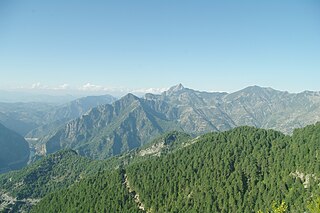
Tripolis on the Meander – also Neapolis, Apollonia, and Antoniopolis – was an ancient city on the borders of Phrygia, Caria and Lydia, on the northern bank of the upper course of the Maeander, and on the road leading from Sardes by Philadelphia to Laodicea ad Lycum. It was situated 20 km to the northwest of Hierapolis.
Savatra, Sabatra, or Soatra was a city in the Roman province of Galatia, and subsequently the Byzantine province of Lycaonia.
Titiopolis or Titioupolis was a town of ancient Cilicia and later in the Roman province of Isauria.
Germanicopolis was an ancient town in Bithynia, also known as Caesarea in Bythinia (not to be confused with Caesarea Germanica, as such a former bishopric and present Latin Catholic titular see.
Zaliche or Zaliches (Ζαλίχης) was an ancient town in the late Roman province of Helenopontus.
Cestrus was a city in the Roman province of Isauria, in Asia Minor. Its placing within Isauria is given by Hierocles, Georgius Cyprius, and Parthey's. While recognizing what the ancient sources said, Le Quien supposed that the town, whose site has not been identified, took its name from the River Cestros and was thus in Pamphylia. Following Lequien's hypothesis, the 19th-century annual publication Gerarchia cattolica identified the town with "Ak-Sou", which Sophrone Pétridès called an odd mistake, since this is the name of the River Cestros, not of a city.
Trapezopolis or Trapezoupolis (Τραπεζούπολις) was a city of ancient Caria, and later in the late Roman province of Phrygia Pacatiana Prima.

Irenopolis or Eirenopolis or Eirenoupolis was an ancient Roman, Byzantine and medieval city in northeastern Cilicia, not far from the Calycadnus river, also known briefly as Neronias in honour of the Roman emperor Nero. Irenopolis was also an episcopal see that is now included in the Catholic Church's list of titular sees.

The Diocese of Hierapolis in Phrygia, was a Christian bishopric in Phrygia.
The Diocese of Alexandretta is a titular Christian bishopric centred on the town of Alexandretta in Turkey. It is also known as Alexandrinus or Cambysopolis. The bishopric of Alexandria Minor was a suffragan of Anazarbus, the capital and so also the ecclesiastical metropolis of the Roman province of Cilicia Secunda. No longer a residential diocese, Alexandria Minor is today listed by the Catholic Church as a titular see.

The Diocese of Laodicea in Phrygia, is an important Titular Christian Diocese, centered on the biblical city of Laodicea on the Lycus in modern Turkey. The Church at Laodicea was a centre of Christianity from a very early point. The New Testament indicates a Christian presence in Laodicea as early as the AD 50s. The church is mentioned extensively in the epistle to the Colossians, and the First Epistle to Timothy may have been written here. Further, the church was one of the Seven churches of Asia. A bishop was appointed in Apostolic Times, with numerous suffragean bishop attached.
Meloë was a town in ancient Lycia, located near Cape Kilidonia.

Pella in Palaestina is an ancient and titular diocese of the Roman Catholic Church also called the Diocese of Khirbet El-wahadneh, and it is centered on Pella, Jordan.
Metropolis in Asia is both a Roman era city and a vacant titular see located in the ecumenical Province of Asia, in what is today Tratsa, Turkey and Haidarli
The Metropolis of Iconium is a metropolitan bishopric of the Ecumenical Patriarchate of Constantinople located at Iconium in Asia Minor, in the region of Lycaonia. It flourished through the Roman and Byzantine empires, and survived into the Ottoman Empire until the early 20th century and the Greco-Turkish population exchange, which led to the disappearance of the local Christian population.
The Holy Metropolis of Tricca, Gardiki and Pyli, is a metropolis under the jurisdiction of the Church of Greece. The metropolis is centered on the cities of Trikala and Kalabaka located in Thessaly, in central Greece.
Vasada was a city of ancient Lycaonia and later of Isauria, Asia Minor. It was located a little to the southwest of Laodiceia. In the acta of church councils attended by its bishop, the name appears variously as Usada or Ousada (Οὔσαδα) or Aasada (Ἀάσαδα).

Cinna or Kinna was a town of ancient Galatia. It was also the seat of a bishop; no longer a residential see, it remains a titular see of the Roman Catholic Church.
Kanna or Kana was a town of ancient Lycaonia, inhabited in Roman and Byzantine times, when it was a bishopric suffragan of Iconium.
Homana, also known as Homona and Homonanda, was a town of ancient Pisidia and later of Isauria and Lycaonia, inhabited in Hellenistic and Roman times. Pliny the Elder puts the town in Pisidia. It appears in the Synecdemus as part of Lycaonia under the name Umanada or Oumanada. It was the capital of the Homanadeis (Ὁμαναδεῖς), who, besides Homana, are said by Tacitus to have possessed 44 forts, a statement opposed to the remarks of Strabo, according to which the Homanades, the most barbarous of all Pisidian tribes, dwelt on the northern slope of the highest mountains without any towns or villages, living only in caves. In the reign of Augustus, the consul Quirinius compelled this little tribe, by famine, to surrender, and distributed 4000 of them as colonists among the neighbouring towns. It became a bishopric; no longer the seat of a residential bishop, it remains, under the name of Homona, a titular see of the Catholic Church.







